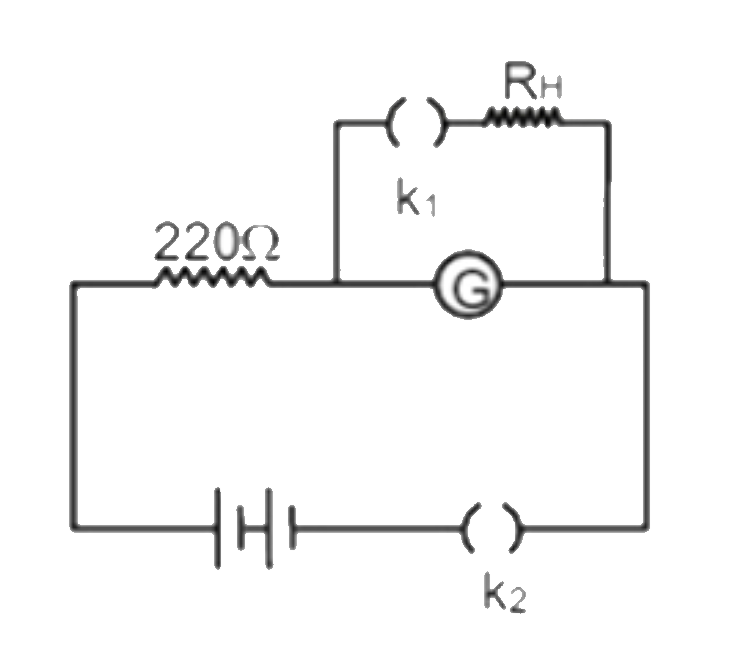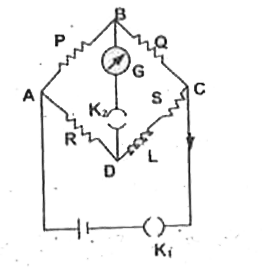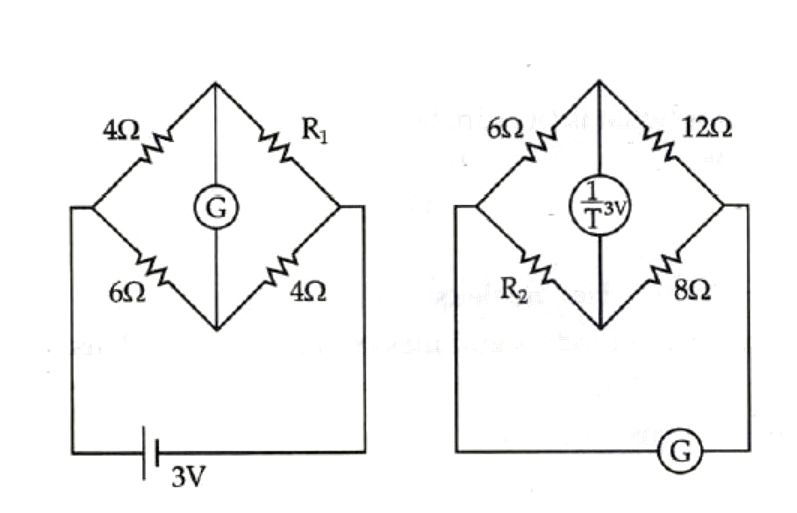The galvanometer deflection , when key K1 is closed but K2 is open equals θ0 (see figure ) On closing k2 also and adjusting R2 to 5Ω , the deflection in galvanometer becomes θ05 the resistnce of the galvanometer is then , given by [Neglect the internal resistance of battery]:
![The galvanometer deflection , when key K(1) is closed but K(2) is open equals theta(0) (see figure ) On closing k(2) also and adjusting R(2) to 5Omega , the deflection in galvanometer becomes (theta(0))/(5) the resistnce of the galvanometer is then , given by [Neglect the internal resistance of battery]:](https://d10lpgp6xz60nq.cloudfront.net/physics_images/JMA_2019_PC_IEH_12_JAN_I_E01_027_Q01.png)
The correct Answer is:22
Deflection in galvanometer is proportional to galvanoeter current θ0∝ig⇒θ0K=ig
Situation 1 Kθ0=v220+R ………(i)
Situation 2 Kθ05=v(220+5R5+R)×55+R
From (i) and (2) R=22Ω.
Topper's Solved these Questions
Similar Questions
100mA current gives a full scale deflection in a galvanometer of 2Ω resistance. The resistance connected with the galvanometer to convert it into a voltmeter to measure 5V is
View SolutionAs shown in the figure initially switch k1 is open and k2 is closed and deflection of galvanometer is x. Now both switch are closed then the deflection in galvanometer is x/5 (given RH=5Ω). The resistance of galvanometer is
 View Solution
View SolutionTo locate null point deflection battery key (K1) ios pressed before the galvanometer (K2) Explanation why?
View SolutionThe resistances P,Q,R and S in the bridge shown are adjusted such that the deflection in the galvanometer G is zero when both the keys K1 and K2 are inserted. The galvanometer will show a momentary deflection if
 View Solution
View SolutionTo locate null point, deflection battery key K1 is pressed before the galvanometer key K2. Explain why?
View SolutionThe deflection in a moving coil galvanometer falls from 50 divisions when a shunt of 2Ω is applied. What is the resistance ( in ohms ) of the galvanometer ?
View SolutionIn the circuits shown in the figures, the galvanometers show no deflection. Find the ratio of R1 and R2.
 View Solution
View SolutionIn the given potentiometer circuit length of the wire AB is 3m and resistance is R=4.5Ω. The length AC for no deflection in galvanometer is
 View Solution
View SolutionA galvanometer of 50Ω resistance when connected across the terminals of a battery of emf 2V along with the resistance 200Ω the deflection produced in the galvanometer is 10 divisions. If the total number of divisions on the galvanometer ·scale on either side of central zero is 30, then the maximum current that can pass through the galvanometer is
View SolutionWhen a galvanometer is shunted with a 4Ω resistance, the deflection is reduced to 1/5. If the galvanometer is further shounted with a 2Ω wire, the new deflection will be (assuming the main current remains the same)
View Solution

